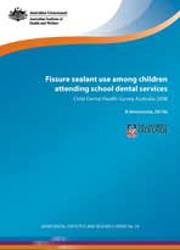Summary
This publication reports on the oral health, including dental decay experience and use of fissure sealants, of Australian children examined by school dental service (SDS) staff in 2008.
The findings are drawn from the 2008 Child Dental Health Survey (CDHS), from which the data of 63,870 children aged 6-12 from all states and territories, except New South Wales and Victoria, were extracted and analysed.
Deciduous teeth
Approximately 52% of children aged 6 had experienced decay in deciduous (baby) teeth, with 1 or more decayed, missing and filled deciduous teeth (dmft).
On average, children aged 6 had more than 2 dmft.
The 10% of children aged 6 who had the most extensive history of deciduous tooth decay had almost 10 deciduous teeth affected. This was more than 4 times the average at age 6.
Permanent teeth
Among 12-year-old children, 45.3% had experienced decay in their permanent teeth with 1 or more decayed, missing and filled permanent teeth (DMFT).
On average, 12-year-old children had just over 1 affected tooth (mean DMFT = 1.11).
The 10% of children aged 12 who had the most extensive history of permanent tooth decay had 5.03 permanent teeth affected-this was almost 5 times the average at age 12.
Fissure sealants
There was an association between age and fissure sealant use-the mean number of fissure sealed teeth was 0.1 at age 6, and 0.8 at age 12.
From 1989 to 2001, the average number of fissure sealed teeth in 12-year-olds increased threefold. Thereafter use decreased.
A higher proportion of children with teeth decay had fissure sealants than those without decay.
Despite the use of fissure sealants decreasing since 2001, there has been an increasing tendency to provide fissure sealants to children who are at risk of decay. Given that an account of preventive treatment data except for fissure sealants is not available in the CDHS, fissure sealant use can be considered as an indicator of preventive care.



